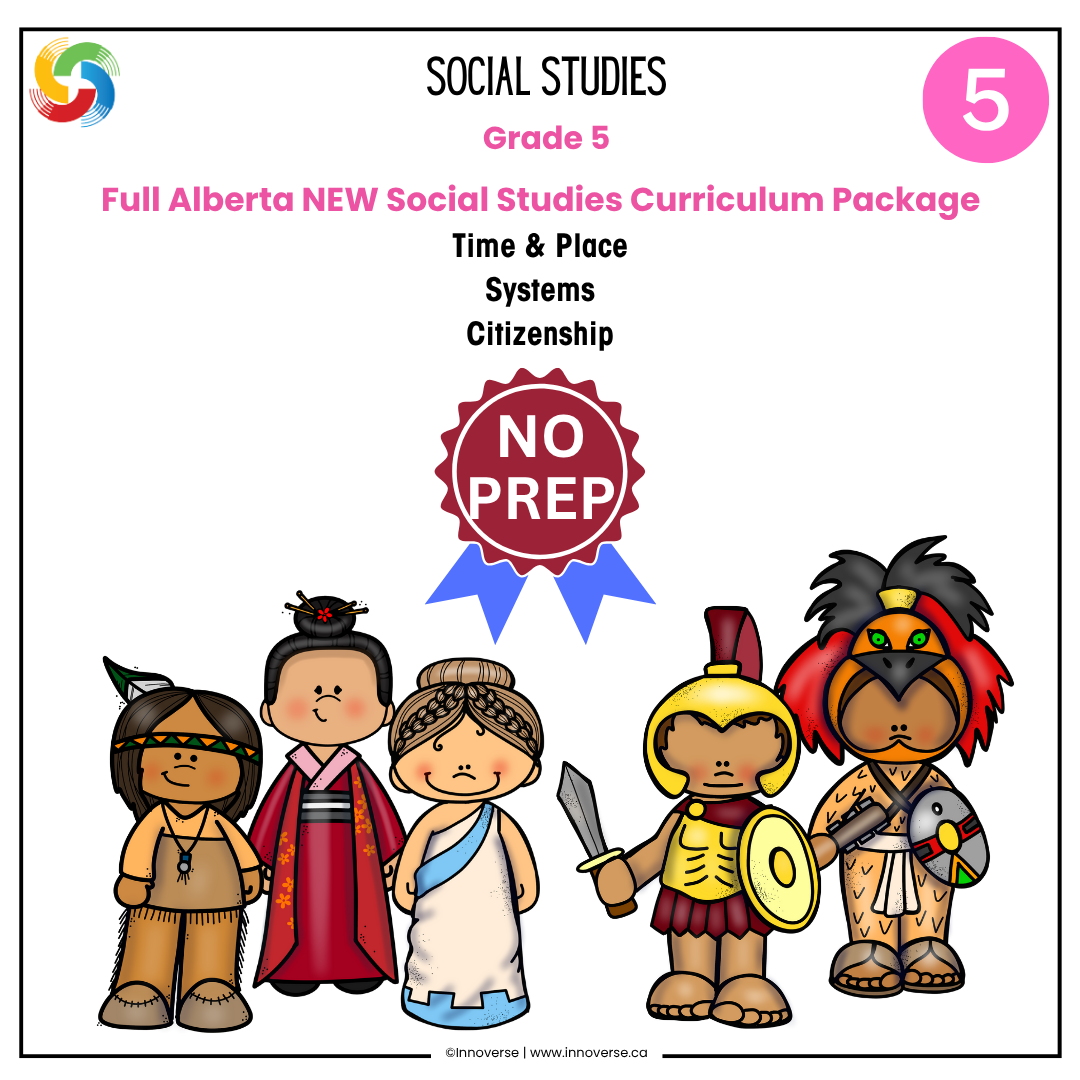Unraveling Ancient Civilizations: Your No-Prep Grade 5 Social Studies Workbooks for Alberta’s New Curriculum!
The new Alberta K-6 Social Studies curriculum offers a captivating journey through time, and for Grade 5 Social Studies, that journey takes us deep into the fascinating world of ancient civilizations and empires. While the Grade 4-6 curriculum becomes mandatory in September 2026, it’s already available for optional implementation in the 2025-2026 school year. This means many of you are actively seeking robust, reliable, and easy-to-use Alberta curriculum resources to prepare.
You’re not alone if you’ve found that finding comprehensive, Alberta curriculum-aligned Grade 5 Social Studies materials can be a challenge, especially with the recent curriculum changes. That’s why I’ve meticulously developed my Alberta Grade 5 Social Studies No-Prep Workbook Set – your ultimate partner in bringing ancient history to life!
Bridging the Digital Divide with Accessible Learning
I understand the varied learning environments across Alberta. Screen time is another important consideration; do we really want students to be on a screen all day? Probably not. Plus, logging in and out of different applications can be a lot for a family to manage. Homeschooling in Alberta, or homeschooling anywhere is not exactly easy. My solution? These printable Alberta Grade 5 Social Studies workbooks are designed for paper-based learning, offering a familiar and low-tech approach that’s perfect for:
-
Alberta homeschooling families seeking a structured, comprehensive Grade 5 Social Studies curriculum for homeschooling.
-
Students engaged in remote learning programs or adaptive learning environments where offline accessibility is key.
But “paper-based” doesn’t mean “limited”! Each workbook is enriched with strategically embedded QR codes for educational videos. With a simple scan using a tablet or smartphone, students can instantly access curated video content that visually explains complex concepts. Imagine your students:
-
Watching animations illustrating different measurements of time based on worldview (linear vs. cyclical).
-
Taking virtual tours of ancient cities and their geographical features.
-
Understanding the rise and fall of ancient empires like Kush and Axum.
-
Visualizing the impact of technological innovations in ancient civilizations like aqueducts or early writing systems.
This seamless integration of multimedia-enhanced learning provides a truly blended learning experience that is engaging and highly accessible, without the stress of multiple logins or software.
Comprehensive Coverage of All Grade 5 Social Studies KUSPs
This no-prep Grade 5 Social Studies package is more than just worksheets; it’s a meticulously designed guide through every Knowledge, Understanding, Skill, and Procedure (KUSP) outlined in the new Alberta Grade 5 Social Studies curriculum. Your students will actively engage with:
Time and Place: Studying People, Places, and Events
-
Social Science Methods: Explore how social scientists (historians, archaeologists, anthropologists, geographers) gather and interpret information from diverse primary and secondary sources (artifacts, maps, timelines, letters, wampum).
-
Time and Chronology: Master timelines (using CE and BCE), understanding how time is measured in different ways based on worldview, and constructing chronologies of ancient civilizations.
-
Maps & Geography: Analyze maps (topographic, climate, political), understand elements like scale, latitude, and longitude, and use absolute location to pinpoint ancient cities.
-
Interpretation & Worldview: Develop critical thinking by understanding that interpretations of events may vary depending on personal experience, location, time, and worldview.
-
Research Skills: Apply social science research processes from formulating questions and gathering information to drawing conclusions, citing reliable sources, and limiting bias in research.
-
Ancient Civilizations & Environment: Investigate how geographical features (river valleys, coastlines) and environmental changes (flooding, drought) contributed to the settlement and trade of ancient civilizations (e.g., Egypt, Greece, Rome, China, India, Arab civilizations).
-
Agriculture & Urbanization: Understand the significance of agriculture (irrigation, domesticated animals) in shifting from nomadic to settled societies, leading to urban settlements with specialized jobs and the development of early economic practices (markets, currency, taxation).
-
People-Environment Relationship: Analyze the reciprocal relationship between people and the environment, examining how ancient civilizations adapted to or modified their natural surroundings (e.g., canals, aqueducts, terrace farming) and the intended and unintended consequences of these changes.
Systems: Government and Organization of Civilizations and Empires
-
Defining Civilizations & Empires: Explore the characteristics that define civilizations, empires, and dynasties, and how technological innovations (writing systems, architecture, calendars, metallurgy) contributed to their success.
-
Trade Routes & Cultural Exchange: Investigate extensive networks of land-based and water-based trade routes (e.g., Silk Road, Trans-Saharan), understanding how they facilitated the exchange of goods, cultures, innovations, and ideas (religions, medicine, worldviews), as well as the challenges faced by traders.
-
Taxation: Discover the origins of taxes in ancient societies and how governments used them to provide community services.
-
Complex Organization: Analyze how complex organizational systems (governments, legal systems, class structures, economic systems) developed with population expansion.
-
Authoritarian Rule: Examine authoritarian governments prevalent in most ancient civilizations and empires, including oligarchies, monarchies, and dictatorships, and the reasons people followed such leaders (tradition, stability, fear). Students will critique opportunities and challenges with authoritarian rule.
-
Social Class Structures: Compare hierarchical social class structures (patricians/plebians, Varna system) and their impact on power, privilege, rights, and social mobility, including the reality of enslavement in ancient societies and gender roles (patriarchal, matriarchal, egalitarian).
-
Rise and Decline of Civilizations: Determine the internal and external factors that led to the rise and decline of civilizations and empires (e.g., military conquest, rebellions, environmental changes, economic disputes), including examples like the African empires (Kush, Axum, Ghana, Mali, Songhai) and Asian empires (Ottoman, Mongol), and the effects of colonization on Indigenous populations (Aztecs, Inca, Maya).
Citizenship: Legacies and Taking Action
-
Enduring Legacies: Analyze the enduring legacies of ancient civilizations and empires (art, architecture, astronomy, medicine, writing systems, philosophy, government structures, trade routes) and how they influence people, places, and events in the world today.
-
Understanding Contemporary Issues: Connect the study of ancient societies to understanding complex contemporary issues, such as how technology created turning points or how economics influenced trade.
-
Informed Citizenship: Develop skills for informed citizenship by seeking information from diverse sources, comparing perspectives on issues, and using this understanding to respond to local, provincial, national, and global events through various actions.
Your Go-To Resource for Grade 5 Social Studies:
This comprehensive Alberta Grade 5 Social Studies no-prep workbook set offers:
-
Ready-to-Print Workbooks: Instantly implementable content, saving you hours of curriculum alignment and resource creation.
-
Embedded QR Codes: Effortless integration of rich multimedia content to deepen understanding.
-
Complete Answer Keys: Simplify grading and provide immediate, accurate feedback.
-
Versatile Use: Perfect for Alberta homeschooling, remote or adaptive learning, and as an invaluable backbone for the regular classroom teacher. It’s also an ideal emergency substitute teaching plan.
Don’t let the new curriculum feel overwhelming. Empower your Grade 5 students with a structured, engaging, and accessible path to understanding ancient civilizations and their lasting impact on our world.

